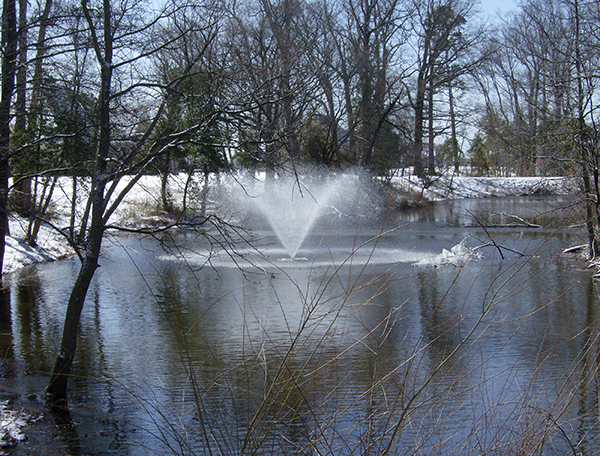Pond Management and Water Quality Control in Cold Weather
July 21st, 2009
 As fall and the cold of winter approach, there are many things that should still be done to maintain the health of our lakes and stormwater retention ponds. As the algae and unwanted aquatic vegetation that often times plagues a pond during the warmer months of spring and summer fades away and goes dormant for the winter, it is very common for many homeowners to turn their attention away from their lakes and storm water ponds. What many people do not realize is that what is done, or not done, during these months, can be just as important as what is done with these water bodies during the warmer months of the year.
As fall and the cold of winter approach, there are many things that should still be done to maintain the health of our lakes and stormwater retention ponds. As the algae and unwanted aquatic vegetation that often times plagues a pond during the warmer months of spring and summer fades away and goes dormant for the winter, it is very common for many homeowners to turn their attention away from their lakes and storm water ponds. What many people do not realize is that what is done, or not done, during these months, can be just as important as what is done with these water bodies during the warmer months of the year.
One of the most significant contributors to water quality problems in a lake or pond is the mass loading of that pond with nutrients that flow in with storm water runoff from yards, sidewalks, driveways, streets, roofs, and all other impervious surfaces within a community. Most people tend to rely very heavily on fertilizers for the lawns and shrubs during the fall. Improper or over application of these products can have very damaging effects on the water to which they flow. All residents within a community and the watershed should pay very close attention to label directions, and make sure that a minimal amount of fertilizer is applied each year.
Communities who have pond aeration systems, whether it be a floating fountain aerator or a submersed air diffused aeration system, should take this opportunity to perform any routine maintenance that is required. It is imperative that these aeration systems continue to operate all winter long. The benefits of pond aeration on a pond are not limited to only the warm months.
Additionally, much research has been done over recent years to develop beneficial microbes that are effective in nutrient management, breaking down nutrients and organic buildup in ponds even during cooler weather. These products work very well in conjunction with aeration to rid the lakes and ponds of the excess nutrient and organic buildup, thus bringing the pond back into an ecological balance, and helping to prevent many potential water quality problems.
Finally, the prevention of sunlight penetration into the water column through the application of pond dye will help to ensure that any unwanted aquatic vegetation that sits dormant on the bottom during the winter will be unable to come out of that winter dormancy in the spring.
Most importantly of all, pay attention to your ponds and the environmental practices that surround and affect them. Remember that most problems can be avoided if dealt with properly. The flow of contaminants into our ponds does not stop just because the weather gets cold, so why should our management and stewardship of these ponds stop? Responsible lake and pond management is a year round endeavor.
Kevin Tucker is the president of SOLitude Lake Management. Since 1998, SOLitude Lake Management has been committed to providing full service lake and pond management services that improve water quality, preserve natural resources, and reduce our environmental footprint. Services are available throughout the Eastern United States. Fisheries management consulting and aquatic products are available nationwide. Learn more about SOLitude Lake Management and purchase products at www.solitudelakemanagement.com.
Find Your Water Quality Solution
Contact the experts at 888-480-5253 for all of your lake, pond and fisheries management needs.
.










